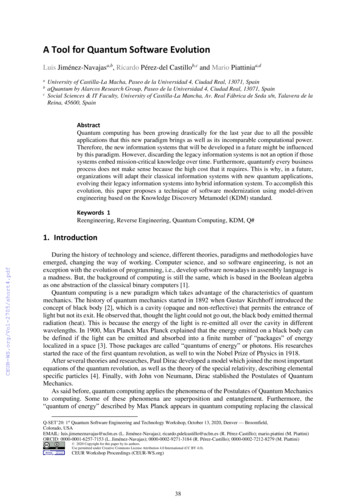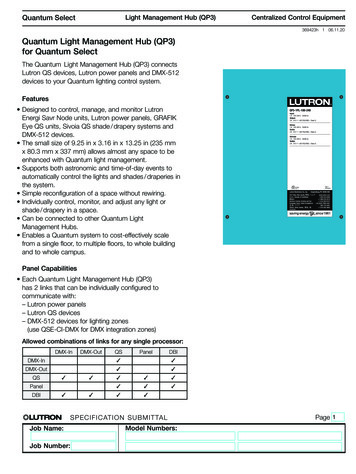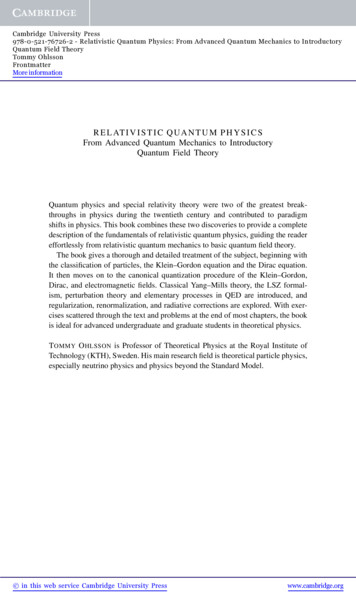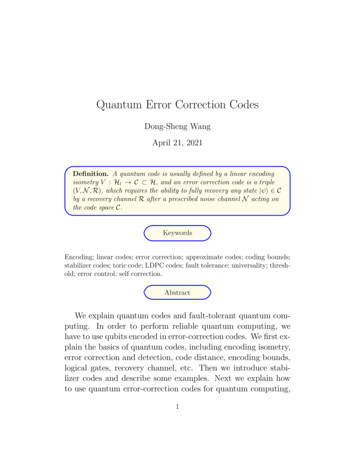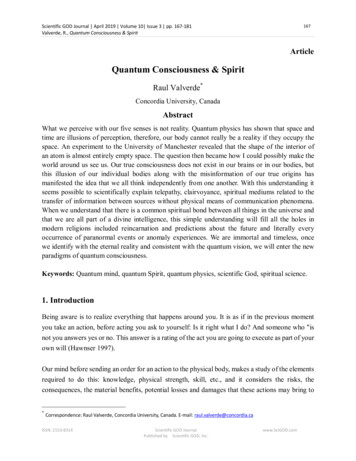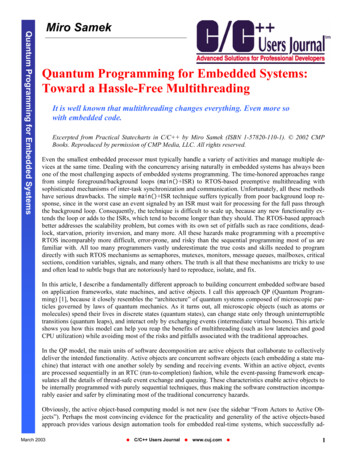
Transcription
Quantum Programming for Embedded SystemsMiro SamekQuantum Programming for Embedded Systems:Toward a Hassle-Free MultithreadingIt is well known that multithreading changes everything. Even more sowith embedded code.Excerpted from Practical Statecharts in C/C by Miro Samek (ISBN 1-57820-110-1). 2002 CMPBooks. Reproduced by permission of CMP Media, LLC. All rights reserved.Even the smallest embedded processor must typically handle a variety of activities and manage multiple devices at the same time. Dealing with the concurrency arising naturally in embedded systems has always beenone of the most challenging aspects of embedded systems programming. The time-honored approaches rangefrom simple foreground/background loops (main() ISR) to RTOS-based preemptive multithreading withsophisticated mechanisms of inter-task synchronization and communication. Unfortunately, all these methodshave serious drawbacks. The simple main() ISR technique suffers typically from poor background loop response, since in the worst case an event signaled by an ISR must wait for processing for the full pass throughthe background loop. Consequently, the technique is difficult to scale up, because any new functionality extends the loop or adds to the ISRs, which tend to become longer than they should. The RTOS-based approachbetter addresses the scalability problem, but comes with its own set of pitfalls such as race conditions, deadlock, starvation, priority inversion, and many more. All these hazards make programming with a preemptiveRTOS incomparably more difficult, error-prone, and risky than the sequential programming most of us arefamiliar with. All too many programmers vastly underestimate the true costs and skills needed to programdirectly with such RTOS mechanisms as semaphores, mutexes, monitors, message queues, mailboxes, criticalsections, condition variables, signals, and many others. The truth is all that these mechanisms are tricky to useand often lead to subtle bugs that are notoriously hard to reproduce, isolate, and fix.In this article, I describe a fundamentally different approach to building concurrent embedded software basedon application frameworks, state machines, and active objects. I call this approach QP (Quantum Programming) [1], because it closely resembles the “architecture” of quantum systems composed of microscopic particles governed by laws of quantum mechanics. As it turns out, all microscopic objects (such as atoms ormolecules) spend their lives in discrete states (quantum states), can change state only through uninterruptibletransitions (quantum leaps), and interact only by exchanging events (intermediate virtual bosons). This articleshows you how this model can help you reap the benefits of multithreading (such as low latencies and goodCPU utilization) while avoiding most of the risks and pitfalls associated with the traditional approaches.In the QP model, the main units of software decomposition are active objects that collaborate to collectivelydeliver the intended functionality. Active objects are concurrent software objects (each embedding a state machine) that interact with one another solely by sending and receiving events. Within an active object, eventsare processed sequentially in an RTC (run-to-completion) fashion, while the event-passing framework encapsulates all the details of thread-safe event exchange and queuing. These characteristics enable active objects tobe internally programmed with purely sequential techniques, thus making the software construction incomparably easier and safer by eliminating most of the traditional concurrency hazards.Obviously, the active object-based computing model is not new (see the sidebar “From Actors to Active Objects”). Perhaps the most convincing evidence for the practicality and generality of the active objects-basedapproach provides various design automation tools for embedded real-time systems, which successfully ad-March 2003C/C Users Journalwww.cuj.com1
Quantum Programming for Embedded SystemsMiro SamekQuantum Programming for Embedded Systemsdress an amazingly wide range of applications (see sidebar “Design Automation Tools for Embedded RealTime Systems”). Virtually every such tool incorporates a variant of an active object-based framework. Forinstance, ROOM (Real-Time Object-Oriented Modeling) calls such a framework the “ROOM virtual machine” [3]. A visualSTATE tool from IAR Systems calls it a “visualSTATE engine” [5]. A UML-compliantdesign automation tool from I-Logix, Rhapsody, calls it an OXF (Object Execution Framework) [6].From Actors to Active ObjectsThe concept of autonomous software objects communicating by message passing dates back to thelate 1970s, when Carl Hewitt and colleagues developed the notion of an actor [2]. In the 1980s, actorswere all the rage within the distributed artificial intelligence community, much as agents are today. Inthe 1990s, methodologies like ROOM [3], adapted actors for real-time computing. More recently, theUML specification has introduced the concept of an active object that is essentially synonymous withthe notion of an actor [4]. Active objects in the UML specification are the roots of threads of controlin multitasking systems and engage one another asynchronously via events. The UML specificationfurther proposes the UML variant of statecharts, with which to model the behavior of event-driven active objects.In QP, I use the UML term "active object," rather than the more compact "actor," to avoid confusionwith the other meaning of the term "actor" that the UML specification uses in the context of usecases. QP incorporates a minimal implementation of an active object-based framework, which I call QF (QuantumFramework), with goals similar to the ROOM virtual machine or Rhapsody’s OXF. However, unlike theframeworks buried inside design automation tools, the QF is intended for direct (manual) coding and is currently available either in C or in C . The framework has a small memory footprint (around 5 KB in mostcases) and executes the applications deterministically. It can be freely embedded in commercial products.Design Automation Tools for Embedded Real Time SystemsSome of the design automation tools for embedded real-time systems capable of automatic code synthesis from visual models include:* Statemate and Rhapsody (I-Logix, www.ilogix.com ),* Rational Suite Development Studio Real-Time (Rational Software Corp., www.rational.com ),* BetterState (WindRiver Systems, www.wrs.com ),* Stateflow (MathWorks, www.mathworks.com ),* VisualState (IAR, www.iar.com ),* ObjectGeode (Telelogic, www.telelogic.com ). Pitfalls of Conventional MultithreadingThe classic DPP (“dining philosophers” problem) posed and solved by Edsger Dijkstra [7] illustrates well thebasic challenges of multithreading. As shown in Figure 1, five philosophers are gathered around a table with abig plate of spaghetti in the middle. The spaghetti is so slippery that a philosopher needs two forks to eat it.Between each philosopher is a fork. The life of a philosopher consists of alternate periods of thinking and eating. When a philosopher wants to eat, he tries to acquire forks. If successful in acquiring two forks, he eats fora while, then puts down the forks and continues to think. (An alternative oriental version replaces spaghettiwith rice and forks with chopsticks.) The key question is: Can you write a program for each philosopher thatnever gets stuck?March 2003C/C Users Journalwww.cuj.com2
Quantum Programming for Embedded SystemsMiro SamekQuantum Programming for Embedded SystemsFigure 1 The Dining PhilosophersAlthough mostly academic, the problem is motivated by the practical issue of how to assign resources to concurrent processes that need the resources to do their jobs; in other words, how do you manage resource allocation. The idea is that a finite set of threads is sharing a finite set of resources, and each resource can be usedby only one thread at a time.The fundamental problem is synchronizing access to the forks. In the simplest (and most naïve) solution, thephilosopher threads might synchronize access to the forks using shared memory. To acquire a fork, a philosopher would need to test the corresponding shared flag and proceed only if the flag is cleared. After acquiringthe fork, the philosopher would immediately set the corresponding flag to indicate that the fork is in use.However, this solution has a fundamental flaw. If philosopher A preempts philosopher B just after philosopher B acquires a fork but before the flag has been set, then philosopher A could incorrectly acquire the forkthat philosopher B already has (the corresponding flag is still cleared). This situation is called a race condition. It occurs whenever one thread gets ahead of another in accessing shared data that is changing.123456789101112131415161718enum { N 5};static HANDLE fork[N];// number of dining philosophers// model forks as mutex semaphoresvoid think(long n) {. . . }void eat(long n) { . . . }// called when philosopher n thinks// called when philosopher n eatslong WINAPI philosopher(long n) {// task for philosopher nfor (;;) {// philosopher task runs foreverthink(n);// first the philosopher thinks for a while// after thinking the philosopher becomes hungry.WaitForSingleObject(fork[(n 1)%N], INFINITE); // get left forkWaitForSingleObject(n], INFINITE);// get right forkeat(n);// got both forks, can eat for a whileReleaseMutex(fork[(n 1)%N]);// release left forkReleaseMutex(fork[n]);// release right fork}return 0;}Listing 1 Simple (and incorrect) solution to the dining philosophers problem implemented withWin32 API. The explicit fork flags are superfluous in this solution because they are replaced by theinternal counters of the mutexes.Clearly, the philosopher threads need some method to protect the shared flags, such that access to the flags ismutually exclusive, meaning only one philosopher thread at a time can test and potentially set a shared flag.March 2003C/C Users Journalwww.cuj.com3
Quantum Programming for Embedded SystemsMiro SamekQuantum Programming for Embedded SystemsThere are many methods of obtaining exclusive access to shared resources, such as performing indivisibletest-and-set operations, disabling interrupts, disabling task switching, and locking resources with semaphores.The solution based on semaphores is, in this case, the most appealing because it simultaneously addresses theproblems of mutual exclusion and blocking the philosopher threads if forks are unavailable. Listing 1 shows asimple semaphore-based implementation.The solution from Listing 1 still has a major flaw. Your program might run for a few milliseconds or for ayear (just as the first naïve solution did), but at any moment, it can freeze with all philosophers holding theirleft fork (Listing 1, line 12). If this happens, nobody gets to eat — ever. This condition of indefinite circularblocking on resources is called deadlock.EXERCISE: Execute the dining philosophers example from Listing 1 (the code is available from www.cuj.com/code ). Name at least three factors that affect the probability of a deadlock. Modify the codeto increase this probability. After the system (dead)locks, use the debugger to inspect the state of the forks andthe philosopher threads.Once you realize the possibility of a deadlock (which generally is not trivial), be careful how you attempt toprevent it. For example, a philosopher can pick up the left fork; then if the right fork isn’t available for agiven time, put the left fork down, wait, and try again. (This is a big problem if all philosophers wait the sameamount of time — you get the same failure mode as before, but repeated.) Even if each philosopher waits arandom time, an unlucky philosopher could starve (never get to eat). Starvation is only one extreme exampleof the more general problem of non-determinism because it is virtually impossible to know in advance themaximum time a philosopher might spend waiting for forks (or how long a philosopher thread is preempted ina preemptive multi-tasking system).Any attempt to prevent race conditions, deadlock, and starvation can cause other, more-subtle, problems associated with fairness and sub-optimal system utilization. For example, to avoid starvation, you might requirethat all philosophers acquire a semaphore before picking up a fork. This requirement guarantees that no philosopher starves, but limits parallelism dramatically (poor system utilization). It is also difficult to prove thatany given solution is fair and does not favor some philosophers at the expense of others. The main lesson ofdining philosophers is that multithreaded programming is incomparably harder than sequential programming,especially if you use a traditional approach to multithreading. The conventional design requires a deep understanding of the time domain and operating system mechanisms for inter-thread synchronization and communication, such as various kinds of semaphores, monitors, critical sections, condition variables, signals, message queues, mailboxes, and so on.Therac-25 StoryThe problems associated with multithreading are not just academic. Perhaps the most publicized real-life example of the “free threading” approach to concurrent event-driven software is the Therac-25 story. BetweenJune 1985 and January 1987, a computer-controlled radiation therapy machine called the Therac-25 massivelyoverdosed six people. These accidents have been described as the worst in the 35-year history of medical accelerators. To attribute software failure as the single cause of the accidents is a serious mistake and an oversimplification. However, the Therac-25 story provides an example of an inherently unsafe and practically unfixable software design that resulted mostly from the (still widely applied) “free threading” approach to concurrency combined with the bottom-up (ad hoc) approach to building event-driven software.The detailed analysis performed by Nancy Leveson in Safeware: System Safety and Computers (AddisonWesley, 1995) revealed that the ultimate root causes of all the Therac-25 accidents were various race conditions within the software. For example, one such race condition occurred between the processes of setting upthe bending magnets in preparation for treatment and accepting treatment data from the console. If a skillfuloperator could enter all the required data within about eight seconds (the time needed to set up the magnets),March 2003C/C Users Journalwww.cuj.com4
Quantum Programming for Embedded SystemsMiro SamekQuantum Programming for Embedded Systemsthen occasionally the machine could end up in an inconsistent configuration (partially set for X-ray treatmentand partially set for electron treatment). These exact conditions occurred on April 11, 1986, when the machine killed a patient.Although the Therac-25 software was developed almost three decades ago and was written in PDP-11 assembly language, it illustrates well the main problem of not knowing exactly which mode of operation (state) thesoftware is in at any given time. Actually, the software has no notion of any single mode of operation, butrather tightly coupled and overlapping conditions of operation defined ambiguously by values of multiplevariables and flags, which are set, cleared, and tested in complex expressions scattered throughout the code.This approach can lead to subtle bugs in an application of even a few hundred lines of code. The Therac-25case, however, shows that, when additionally compounded with concurrency issues, the ad hoc approachleads to disastrous, virtually uncorrectable designs. For example, in an attempt to fix the Therac-25 race condition described earlier, the manufacturer (Atomic Energy of Canada Limited) introduced another sharedvariable controlled by the keyboard handler task that indicated whether the cursor was positioned on thecommand line. If this variable was set, then the prescription entry was considered still in progress and thevalue of the Tphase state variable was left unchanged. The following items point out some inherently nastycharacteristics of such ad hoc solutions. Any individual inconsistency in configuration seems to be fixable by introducing yet another moderelated (extended state) variable.Every new extended state variable introduces more opportunities for inconsistencies in the configurationof the system. Additionally, if the variable is shared among different threads (or interrupts), it can introduce new race conditions.Every such change perpetuates the bad design further 3 and makes it exponentially more difficult (expensive) to extend and fix, although there is never a clear indication when the code becomes unfixable (prohibitively expensive to fix).It is practically impossible to know when all inconsistent configurations and race conditions are removed.In fact, most of the time during computations, the configuration is inconsistent, but you generally won’tknow whether it happens during the time windows open for race conditions.No amount of testing can detect all inconsistencies and timing windows for race conditions.Any change in the system can affect the timing and practically invalidate most of the testing.You might think that the Therac-25 case, albeit interesting, is no longer relevant to contemporary softwarepractices. This has not been my experience. Unfortunately, the architectural decay mechanisms just recountedstill apply today, almost exactly as they did three decades ago. The modes of architectural decay haven’tchanged much because they are characteristics of the still widely practiced bottom-up approach to designingreactive systems mixed with the conventional approach to concurrency.Computing model of QPFor the reasons just listed and others, experienced embedded programmers have learned to be extremely waryof shared (global) data and various mutual exclusion mechanisms (such as mutexes). Instead, they structuretheir applications around the event-passing paradigm. For example, Jack Ganssle offers the following advice[9]:Novice users all too often miss the importance of the sophisticated messaging mechanisms that are astandard part of all commercial operating systems. Queues and mailboxes let tasks communicatesafely. the operating system’s communications resources let you cleanly pass a message withoutfear of its corruption by other tasks. Properly implemented code lets you generate the real-timeanalogy of object-oriented programming’s (OOP) first tenet: encapsulation. Keep all of the task’sdata local, bound to the code itself and hidden from the rest of the system.March 2003C/C Users Journalwww.cuj.com5
Quantum Programming for Embedded SystemsMiro SamekQuantum Programming for Embedded Systemsconcreteactive objectsconcreteEventsQF Application active ActiveA active ActiveBEvtAEvtB framework QFQHsm active ryPoolRTOSAPIFigure 2 UML package diagram illustrating relationships among RTOS, QF, and QF-ApplicationIn fact, this piece of advice provides a good, albeit incomplete, description of the active object computingmodel. It captures very well the most important characteristics of active objects—their opaque encapsulationshell, which strictly separates the internal structure of an active object from the external environment. Theonly objects capable of penetrating this shell, both from the outside and from the inside, are event instances.Another crucial aspect of QP is the universal use of hierarchical state machines (HSMs) for modeling the internal structure of active objects. State machines are ideal for coding event-driven systems, because theymake the event handling explicitly dependent on both the nature of the event and on the context (state) of thesystem. Programmatically, state machines enable the crisp definition of the state at any time, which leads todramatic reduction of convoluted paths through the code and simplification of the conditions tested at eachbranching point (recall the Therac-25 story).The high-level structure of the QF (shown in Figure 2) is typical for any active object–based framework. Thedesign is layered with a real-time operating system (RTOS) that provides a foundation for multithreading andbasic services like event queues and memory pools. (For simpler designs, the QF can operate without an underlying RTOS, effectively replacing it.) Based on these services, the QF supplies the QActive base class toderive concrete active objects. QActive inherits from QHsm, which means that active objects inherit are hierarchical state machines. Additionally, QActive gives active objects a thread of execution and an event queue.An application built from the QF extends the framework by subclassing QActive and QEvent. The applicationuses QF communication and timing services through the QF API; however, the application typically shouldnot need to access the RTOS API directly.Dining Philosophers RevisitedEarlier in Listing 1, you saw one of the conventional approaches to the dining philosophers problem. Here, I’dlike to show you a design based on active objects and the Quantum Framework (QF). The purpose of this discussion is to walk you quickly through the main points without slowing you down with the full-blown details.Active object–based programming requires a paradigm shift from the conventional approach to multithreading. Whereas in the conventional approach you mostly think about shared resources and various synchronization mechanisms, in the active object–based approach, you think about partitioning the problem into activeobjects and about exchanging events among these objects. Your goal is to break up the problem in a way thatMarch 2003C/C Users Journalwww.cuj.com6
Quantum Programming for Embedded SystemsMiro SamekQuantum Programming for Embedded Systemsrequires minimal communication. The generic design strategy for handling shared resources is to encapsulatethem inside a dedicated active object and to let that object manage the shared resources for the rest of the system (i.e., instead of sharing the resources directly, the rest of the application shares the dedicated active object). When you apply this strategy to the DPP (Figure 1), you will naturally arrive at a dedicated active objectto manage the forks (call it Table for this example). The Table active object is responsible for coordinatingPhilosopher active objects to resolve contentions over the forks. It’s also up to the Table active object toimplement it fairly (or unfairly if you choose). A Philosopher active object needs to communicate two thingsto Table: (1) when it is hungry and (2) when it finishes eating. Table needs to communicate only one thing toa hungry Philosopher: permission to eat. The sequence diagram in Figure 3 shows two scenarios of possibleevent exchange in the DPP. In the case of Philosopher n, Table can grant permission to eat immediately.However, Philosopher m has to wait in the hungry state until forks become available (e.g., two forks becomefree when Philosopher n is done eating).:QFTimeoutsrequestedto terminatethinkingTimeoutrequestedto )HUNGRY(m)TIMEOUTQF timersgenerate timeoutevents requestedby ble grantspermission to eatimmediately (freeforks are available)Table does notgrant permission toeat until some forksare freeFigure 3 Sequence diagram showing event exchange in the active object–based solution of the DPPThe class diagram in Figure 4 shows that the QF application comprises the Table and Philosopher activeobjects and the specialized TableEvt class. This diagram has a typical structure for an application derivedfrom a framework. Concrete application components (active objects and events in this case) derive fromframework base classes (from QActive and QEvent) and use other frame-work classes as services. For example, every Philosopher has its own QTimer (quantum timer) to keep track of time when it is thinking or eating.QActiveQHsmQF yNummyTimerTable()- initial()- serving()Philosopher()# initial()# thinking()# hungry()# eating()myTimer 1QTimerstate-handlersTableEvtphilNumFigure 4 Table and Philosopher active objects and the TableEvt class derived from the QF baseclassesThe Table and Philosopher active objects derive indirectly from QHsm, so they are state machines. In fact,your main concern in building the application is elaborating their statecharts. Figure 5a shows the statechartMarch 2003C/C Users Journalwww.cuj.com7
Quantum Programming for Embedded SystemsMiro SamekQuantum Programming for Embedded Systemsassociated with Table. It is trivial because Table keeps track of the forks and hungry philosophers by meansof extended state variables (myFork[] and isHungry[] arrays, Figure 4), rather than by its state machine.The Philosopher state machine (Figure 5b) clearly shows the life cycle of this active object consisting ofstates thinking, hungry, and eating. This statechart publishes the HUNGRY event on entry to the hungry state andthe DONE event on exit from the eating state because this exactly reflects the semantics of these events. Analternative approach — to publish these events from the corresponding TIMEOUT transitions — would notguarantee the preservation of the semantics in potential future modifications of the state machine.(a)(b)servingHUNGRY(n)/DONE(n)/eatingexit/ try/ HUNGRY(n)Figure 5 (a) Table statechart and (b) Philosopher statechart; the DONE(n) notation indicatespropagation of the DONE event with parameter n (for the n -th Philosopher)Note that, externally, the active object–based solution makes no reference whatsoever to the forks, only to thephilosopher’s right to eat (refer to the sequence diagram in Figure 3). Interestingly, Dijkstra [7] proposed asimilar solution as the “most natural.” His formal analysis of the problem further deduced a need for each philosopher to have an “I am hungry” state, in which the philosopher would wait for permission to eat. Overall,Dijkstra’s solution has many remarkable parallels to the active object–based design. Each Philosopher life cycle goes through thinking, hungry, and eating states (refer to the Philosopherstatechart in Figure 5b).Each Philosopher has a private semaphore on which to wait when hungry (waiting on this semaphorecorresponds to blocking the Philosopher thread on the private event queue inherited from the QActivebase class).A Philosopher starts eating when in the hungry state and neither neighbor is eating (in active object–based design, this is handled by Table; refer to the handling of the HUNGRY event in Figure 3)When a Philosopher finishes eating, any hungry neighbor starts eating (in active object–based design,this is handled by the Table active object; refer to the handling of the DONE event in Figure 3)EXERCISE: Execute the QP version of the dining philosophers (the Windows version is available from www.cuj.com/code ). Check that the Table hands out the forks correctly to the hungry Philosophers.Unprecedented FlexibilityYou might object rightly that the active object-based solution to the DPP is bigger (when measured in lines ofcode) than a typical traditional solution. However, as I try to demonstrate in the following discussion, none ofthe traditional approaches to DPP are in the same class as the active object–based solution.The active object–based solution might be a bit larger than the traditional solution, but the QF-based code isstraightforward and free of all concurrency hazards. In contrast, any traditional solution deals directly withlow-level mechanisms, such as semaphores or mutexes, and therefore poses a risk of deadlock, starvation, orsimply unfairness in allocating CPU cycles to philosopher tasks.However, what sets the active object–based solution truly apart is its unparalleled flexibility and resilience tochange. Consider, for example, how the initial problem could naturally evolve into a more realistic applicaMarch 2003C/C Users Journalwww.cuj.com8
Quantum Programming for Embedded SystemsMiro SamekQuantum Programming for Embedded Systemstion. For instance, starting a conversation seems a natural thing for philosophers to do. To accomplish such anew feature (interaction among the philosophers), a traditional solution based on blocking philosopher threadswould need to be redesigned from the ground up because a hungry (blocked) philosopher cannot participate inthe conversation. Blocked threads are unresponsive.A deeper reason for the inflexibility of the traditional solution is using blocking to represent a mode of operation. In the traditional solution, when a philosopher wants to eat and the forks aren’t available, the philosopherthread blocks and waits for the forks. That is, blocking is equivalent to a very specific mode of operation (thehungry mode), and unblocking represents a transition out of this mode. Only the fulfillment of a particularcondition (the availability of both forks) can unblock a hungry philosopher. The whole structure of the intervening code assumes that unblocking can only happen when the forks are available (after unblocking, the philosopher immediately starts to eat). No other condition can unblock the philosopher thread without causingproblems. Blocking is an inflexible way to implement modal behavior.In contrast, the active object–based computing model clearly separates blocking from the mode (hungry) ofoperation and unblocking from the signaling of certain conditions (the availability of forks). Blocking in active objects corresponds merely to a pause in processing events and does not represent a particular mode ofthe active object. Keeping track of the mode is the job of the active object’s state machine. A blocke
Quantum Programming for Embedded Systems Miro Samek March 2003 C/C Users Journal www.cuj.com Quantum Programmi ng for Embedded Systems 2 dress an amazingly wide range of applications (see sidebar "Design Automation Tools for Embedded Real-Time Systems"). Virtually every such tool incorporates a variant of an active object-based framework.



